God’s threshing floor (Boskie gumno – Boskie Klepisko)
©Autor/ Źródło: Old European culture © tłumaczenie i komentarz Cz. Białczyński
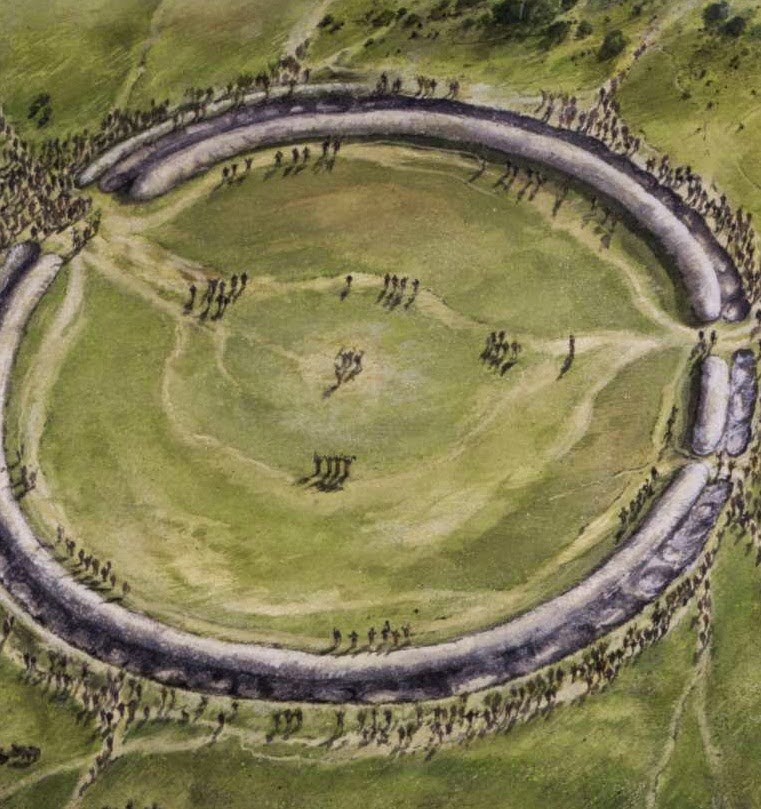
In several of my previous posts I have been talking about sun circles. I talked about their origin in my post about Henges – rondel enclosures. I talked about how they were used as solar observatories for determining the beginning of the lunisolar calendar in my post about Calendars. In my post about Stone circles on mountain Devica, I talked about the solar observatory called Bogovo Gumno from Serbia. In my post about Ognjena Marija I explained how the sun circles on Bogovo Gumno are linked to the week which starts on the 30th of July and ends on the 4th of August.
W kilku moich poprzednich postach mówiłem o kręgach słonecznych. O ich pochodzeniu mówiłem w swoim poście o Henges – obudowany Rondel. Mówiłem o tym, w jaki sposób były one wykorzystywane jako obserwatoria słoneczne do określania początku kalendarza księżycowo-słonecznego w poście o Kalendarzach. W moim poście o Kamiennych kręgach na górze Devica mówiłem o obserwatorium słonecznym Bogovo Gumno w Serbii. W swoim poście Ognjena Marija wyjaśniłem, w jaki sposób kręgi słoneczne na Bogovym Gumno powiązane są z tygodniem rozpoczynającym się 30 lipca i kończącym się 4 sierpnia.
This week is in Serbia called Kresovi (Fires, Lightnings). In Ireland this week is called Domhnach Crom Dubh, the week of Crom Dubh. This week centers around the 2nd of August, the last day of summer and the first day of Autumn, which is in Serbia known as the day of Thunder god Perun or the day of Triglav, Thundering Sun Ilios, and which is in Ireland known as the day of Triglav, Crom Dubh, but also as Lughnasadh, the day of Thunder god Lugh.
Bogovo Gumno sun circles are extremely important for several reasons:
- Bogovo Gumno sun circles could be part of an extremely old and complex astronomic and religious complex.
- Bogovo Gumno sun circles give us a proof that prehistoric astronomic solar observatories continued to be used millenniums after they were built by the local population for calendar calculation and religious practices related to solar cycles.
- Bogovo Gumno sun circles can help us understand the stone circle complex known as Grange circles from Ireland and the meaning and significance of the term Grange itself.
- Bogovo Gumno sun circles can help us understand the origin of Jewish and therefore Christian religion.
Ten tydzień w Serbii nazywa się Kresovi (Ognie, Błyskawice). W Irlandii ten tydzień nazywa się Domhnach Crom Dubh, tydzień Crom Dubh. Środek tego tygodnia przypada około 2 sierpnia, czyli ostatniego dnia górowania lata i pierwszego dnia królującej jesieni, który jest w Serbii znany jako dzień boga piorunów Peruna, lub dzień Triglava, Gromowe Słońce Ilios, a który jest w Irlandii znany jako dzień Triglava, Croma Dubha, ale także jako Lughnasadha, dzień boga gromu Lugha.
Kręgi słoneczne Bogovo Gumno są niezwykle ważne z kilku powodów:
1. Kręgi słoneczne Bogovo Gumno mogą być częścią niezwykle starego i złożonego kompleksu astronomicznego i religijnego.
2. Kręgi słoneczne Bogovo Gumno dają nam dowód, że prehistoryczne astronomiczne obserwatoria słoneczne były nadal używane przez tysiąclecia po tym, jak zostały zbudowane przez miejscową ludność do obliczeń kalendarza i praktyk religijnych związanych z cyklami słonecznymi.
3. Kręgi słoneczne Bogovo Gumno mogą pomóc nam zrozumieć kompleks kamiennych kręgów zwanych kręgami Grange z Irlandii ich znaczenie i znaczenie samego terminu Grange.
4. Kręgi słoneczne Bogovo Gumno mogą pomóc nam zrozumieć pochodzenie religii żydowskiej, a zatem chrześcijańskiej.
Being the solar observatory designed to determine and mark the summer solstice, the big stone circle in Bogovo Gumno was also dedicated to the Sun, also known in Serbia as Višnji bog (the high god), Vid. In Serbian tradition, Sun, the „Višnji Bog”, the High God, is perceived as a living being, which is born every year in the winter on New Year’s day, winter solstice. He then grows into a young man Jarilo on the 6th of May the day of the strongest vegetative, reproductive power of the sun. This day marks the beginning of the heating of the world, the beginning of summer. Then he becomes the powerful ruler Vid at the summer solstice, 21st of June the longest day of the year. He then becomes the terrible warrior Perun on the 2nd of August the hottest day of the year. This day marks the beginning of the cooling of the world.
Będąc obserwatorium słonecznym zaprojektowanym do określenia i oznaczenia przesilenia letniego, wielki kamienny krąg w Bogovo Gumno był również poświęcony Słońcu, znanemu również w Serbii jako Višnji bog (najwyższy bóg Vid). Zgodnie z serbską tradycją Słońce, „Bogacz Višnji”, Wielki Bóg, jest postrzegane jako żywa istota, która rodzi się każdego roku zimą w Nowy Rok, podczas przesilenia zimowego. Następnie dorasta do postaci młodego mężczyzny Jariło 6 maja, w dniu największej wegetatywnej, reprodukcyjnej mocy słońca. Ten dzień oznacza początek ogrzewania świata, początek lata. Następnie staje się potężnym władcą Wielkim Videm podczas przesilenia letniego, 21 czerwca, najdłuższego dnia w roku. Następnie staje się okropnym wojownikiem Perunem 2 sierpnia, który jest najgorętszym dniem w roku. Ten dzień jest początkiem ochłodzenia świata.
Summer solstice, the day of Svetovid, Vishnji bog is exactly in the middle of the summer period marked by the day of Jarilo and the day of Perun. Jarilo (heat, fire), Svetovid (light, sun) and Perun (lightning, electricity, energy) are together forming Triglav, Dabog, Hromi Daba, Perun the main god of the Serbs which is in Ireland known as Triglav, Dagda, Crom Dubh, Lugh. This is the Thundering Burning Sun Ilios, Grom Div, the Three in one, Trinity, Trimurti, Agni. He is the sun at its most powerful and terrifying, the sun that contains the cumulative power of the whole summer.
In my post about Triglav i quoted this riddle from the book of Veles:
Jer tajna je velika, kako to Svarog biva u isto vreme i Perun i Svetovid.
Przesilenie letnie, dzień Svetovida, boga Visznji znajduje się dokładnie w środku okresu letniego wyznaczonego między dniem Jariły i dniem Peruna. Jarilo (ciepło, ogień), Svetovid (światło, słońce) i Perun (błyskawica, prąd, energia) tworzą razem Triglav, Dabog, Hromi Daba, Peruna, głównego boga Serbów, który w Irlandii znany jest jako Triglav, Dagda, Crom Dubh, Lugh. To jest Grzmiące Płonące Słońce Ilios (Helios CB), Grom Div, Trzy w jednym, Trinity, Trimurti, Agni. On jest słońcem w najsilniejszym i najstraszniejszym blasku, jaki zawiera skumulowaną moc całego lata.
W moim poście o Triglavie zacytowałem tę zagadkę z Księgi Velesa:
Jer tajna je velika, kako to Svarog biva u isto vreme i Perun i Svetovid.
Jest tajemnicą wielką kiedy to Swarog bywa w tym samym czasie i Perunem i Światowidem.
Translated into English it means:
Because it is a great secret how come Svarog (hevenly and earthly fire) is at the same time Perun (thunder) and Svetovid (Sun).
The answer to this riddle is Triglav (three headed), trojan (triple), Hromi daba, Crom Dubh – Lugh, Grom Div, Agni.
This riddle hides in itself the same sacred knowledge contained in Vedas.
The above religious system is related to vegetative agricultural cycle. It is extremely important to farmers in continental Europe, but it is almost irrelevant to the steppe nomads, and it is completely wrong in Indian climate which is governed by a monsoon. The hottest month for the western and southern regions of India is April; for most of North India, it is May. So where did this religious system originate? I would suggest Europe. I believe that Vedic Solar Religion was brought to India by farmers from Europe, not by Steppe nomads from central Asia.
So on mountain Devica we have a Sun circle used for determining the day of the summer solstice. So what? We have these types of circles all over Europe. Why is this one so significant? The answer to this quesiton is: because of its name and what its name means. The meaning of the name „Bogovo Gumno” means God’s Threshing floor.There is a local legend which says that the Circle is called God’s Threshing floor because in the ancient times god came from heaven with his horses and he threshed grain there.
Threshing floor is a flat, smooth and hard surface used for threshing, a process of separating the grain from the straw and husks.
Odpowiedzią na tę zagadkę jest Triglav (trójgłowy), trojan (potrójny), Hromi Daba, Crom Dubh – Lugh, Grom Div, Agni.
Ta zagadka kryje w sobie tę samą świętą wiedzę, którą zawarto w Wedach.
Powyższy system religijny związany jest z wegetatywnym cyklem rolnym. Jest to niezwykle ważne dla rolników w Europie kontynentalnej, ale jest prawie nieistotne dla koczowników stepowych i jest całkowicie błędne w indyjskim klimacie rządzonym przez monsun. Najcieplejszym miesiącem dla zachodnich i południowych regionów Indii jest kwiecień; dla większości północnych Indii jest maj. Skąd więc ten system religijny? Sugerowałbym Europę. Uważam, że wedyjska religia słoneczna została sprowadzona do Indii przez rolników z Europy, a nie przez koczowników stepowych z Azji Środkowej.
Tak więc na górze Devica mamy koło słoneczne używane do określania dnia przesilenia letniego. Więc co? Mamy tego typu koła w całej Europie. Dlaczego ten krąg jest tak ważny? Odpowiedź na to pytanie brzmi: ze względu na jego nazwę i znaczenie. Znaczenie imienia „Bogovo Gumno” oznacza Bożą Młockę na gumnie (klepisku). Istnieje lokalna legenda, która mówi, że Krąg nazywany jest Bożą Młocką na Gumnie, ponieważ w starożytności Bóg przybył z nieba ze swoimi końmi i młócił tam zboże.
Klepisko gumna jest płaską, gładką i twardą powierzchnią służącą do omłotu, procesu oddzielania ziarna od słomy i łuski.
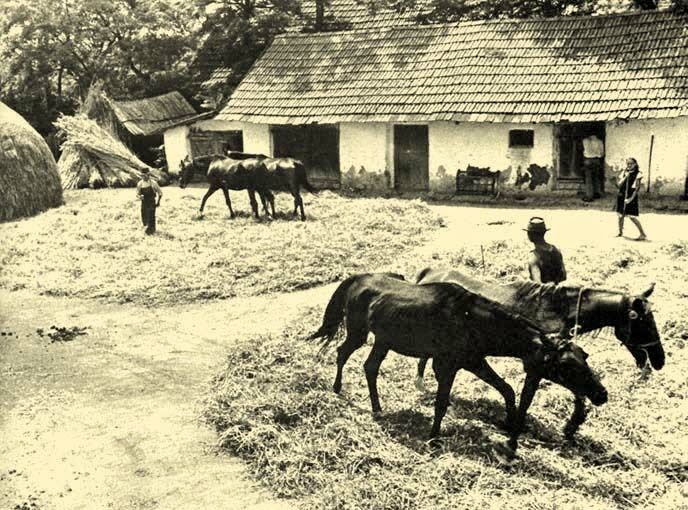
The process of threshing is performed generally by spreading the sheaves on the threshing floor and causing oxen, cattle or horses to tread repeatedly over them. If you look at the picture above you can see that that the animals are made to walk in a circle. In order to make the animals walk in circles, a man needs to stand in the center of the pile of grain which is being threshed and restrict and direct the movement of the oxen, cattle or horses using reins or rope. You can see this technique being used on the above picture. Alternatively a central pole can be erected, to which the animals are tied and then they are urged to walk in circles by a man walking behind them. You can see this technique being used on the below picture.
Proces omłotu odbywa się na ogół przez rozłożenie zboża płasko w kręgu na gumnie i wielokrotne stąpanie po kłosach przez woły, inne bydło lub konie. Jeśli spojrzysz na powyższe zdjęcie, zobaczysz, że zwierzęta są stworzone do chodzenia w kółko. Aby zwierzęta krążyły w kółko, człowiek musi stać pośrodku stosu zboża, który jest młócony, oraz ograniczać i kierować ruchem wołów, bydła lub koni za pomocą wodzy, lub liny. Możesz zobaczyć tę technikę stosowaną na powyższym zdjęciu. Alternatywnie można postawić centralny słup, do którego przywiązane są zwierzęta, a następnie człowiek idący za nimi zachęca je do chodzenia w kółko. Możesz zobaczyć tę technikę na poniższym obrazku.
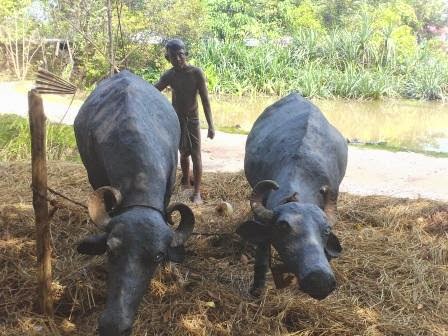
This process loosens the edible part of cereal grain from the scaly, inedible chaff that surrounds it.
Proces ten rozluźnia jadalną część ziarna zbóż z łuszczącej się, niejadalnej plewy, która ją otacza.

On occasions flails or sticks were used for threshing on their own or in combination with treading by oxen, cattle or horses.
Czasami bijaki lub kije (cepy) były używane do omłotu samodzielnie lub w połączeniu z deptaniem przez woły, bydło lub konie.
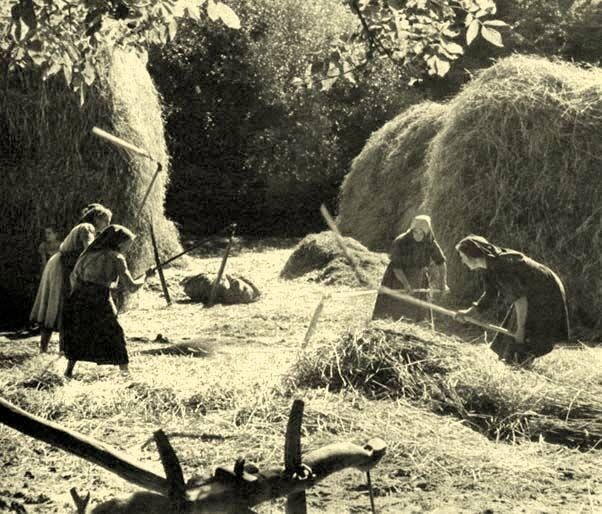
The stalks of hay are separated from the mixture of grains and scaly husks. Hay is put into haystacks and the grain and chaff mixture is ready for winnowing.
Łodygi siana są oddzielone od mieszanki ziaren i łuszczących się łusek. Siano wkłada się do stogów siana, a mieszanka ziarna i plew jest gotowa do siewu.
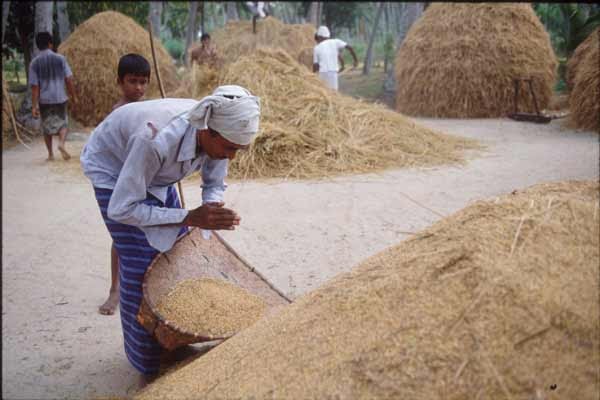
The winnowing consist of throwing the mixture into the air so the wind could blow away the chaff, leaving only the good grain on the floor.
Winnowing can be done in two ways.
By throwing the grain chaff mixture into the air using winnowing forks
Powiewanie polega na wyrzuceniu mieszanki w powietrze, aby wiatr mógł zdmuchnąć plewy, pozostawiając tylko dobre ziarno na podłodze.
Wietrzenie można wykonać na dwa sposoby.
Przez wyrzucenie mieszanki sieczki zbożowej w powietrze za pomocą wideł i zwiewanie

By pouring the grain chaff mixture from the winnowing basket.
Przez sypanie mieszanki sieczki i ziarna z koszyczka.
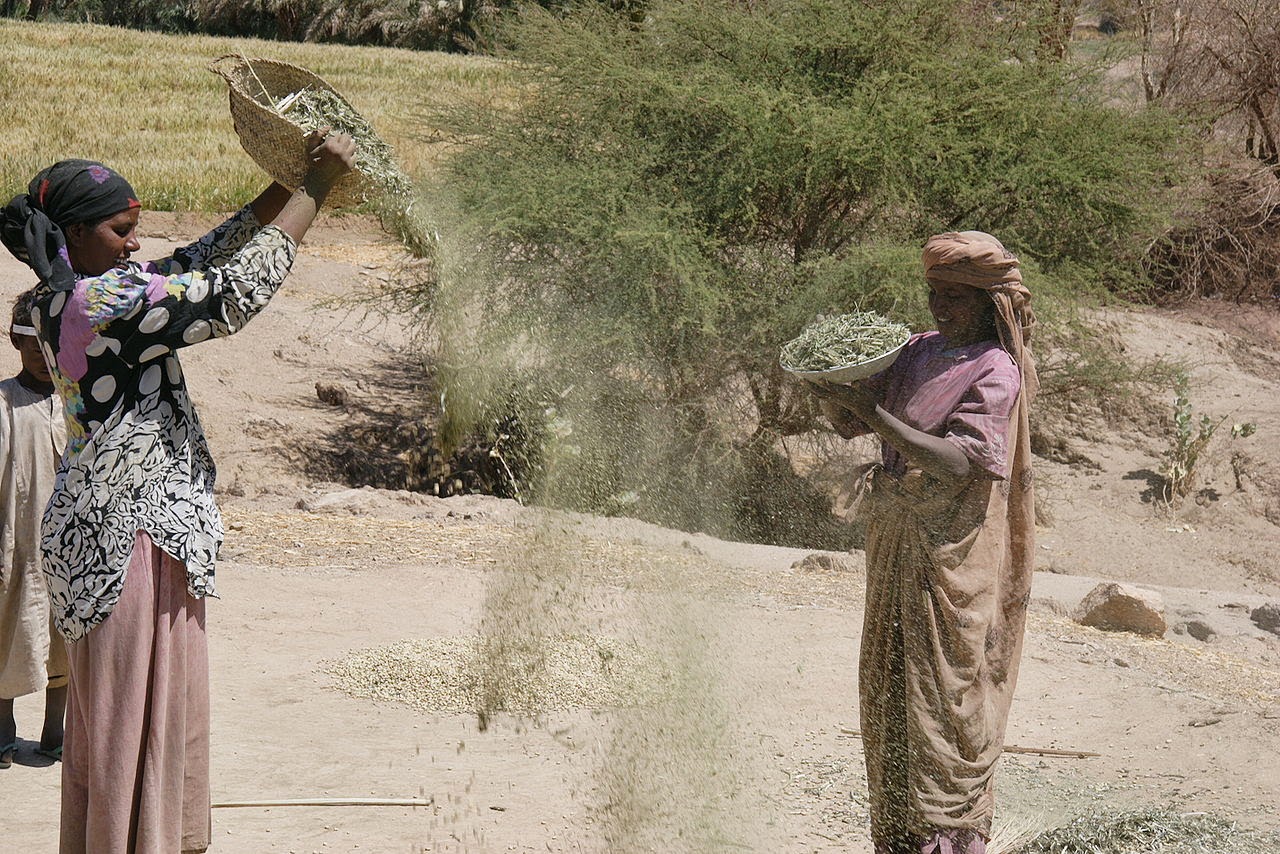
This is why threshing floors are usually built on wind swept places. You need good steady wind for the process of winnowing. So you build your threshing floor on the top of the hill, like this one:
Właśnie dlatego klepiska są zwykle budowane w miejscach o silnym wietrze. Potrzebujesz dobrego stałego wiatru do procesu wietrzenia. Więc budujesz mieć swoje klepisko na szczycie wzgórza, tak jak to:
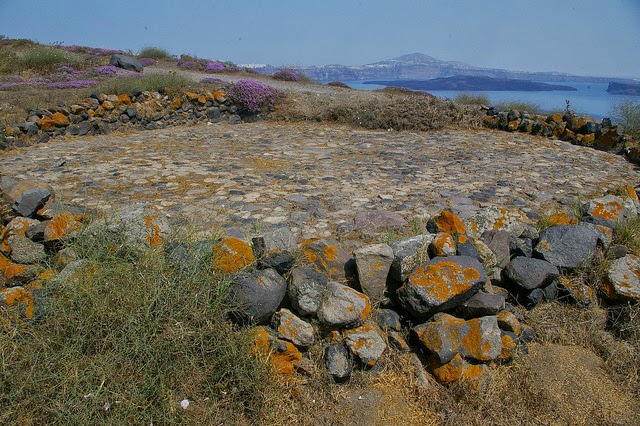
Or on an open plane, like this one:
Lub na otwartej płaszczyźnie, takiej jak ta:
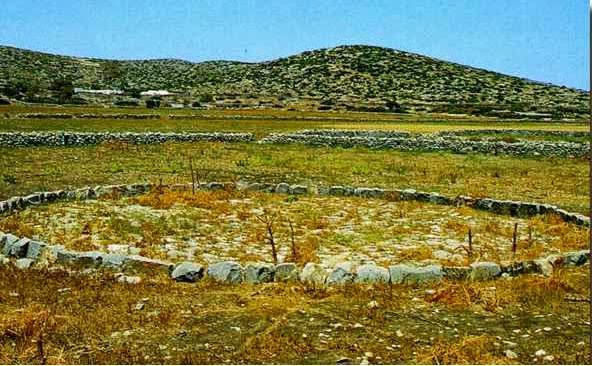
Both locations also have excellent view of the sky and are ideal for solar observation.
You can see that the above threshing floors have a wall built around it. This is done to mark the edge of the threshing circle and to prevent the grain being blown away. This creates a flat shallow pan like circular enclosure. Does this remind you of anything? A sun circle? The design and constriction is exactly the same. You erect a central pole, you tie a rope to it and then you walk around the pole while holding the end of the rope or animals walk around the pole while being tied to the rope. The produced movement describes perfect circle, the sun circle the threshing circle. Here are two depictions of this circular movement of bulls around the threshing floor from ancient Ilios (Troy). They are from an excellent book called The Swastika, by Thomas Wilson.
Obie lokalizacje mają również doskonały widok na niebo i są idealne do obserwacji słonecznych.
Widać, że powyższe klepiska mają wokół siebie niski murek. Wykonuje się go w celu zaznaczenia krawędzi koła omłotowego i zapobieżenia wyrzucaniu ziarna poza krąg. Tworzy to płaską płytką miskę podobną do okrągłej obudowy. Czy coś ci to przypomina? Krąg słoneczny? Konstrukcja i wyznaczenie go są dokładnie takie same. Stawiasz centralny słup, przywiązujesz do niego linę, a następnie obchodzisz go, trzymając koniec liny lub zwierzęta chodzą wokół słupa, będąc przywiązanym do liny. Wytworzony ruch opisuje idealne koło, słońce okrąża koło gumna. Oto dwa obrazy tego samego kolistego ruchu byków wokół klepiska ze starożytnego Ilios/Ilionu (Troji). Pochodzą z doskonałej książki Thomasa Wilsona zatytułowanej „Swastyka”.
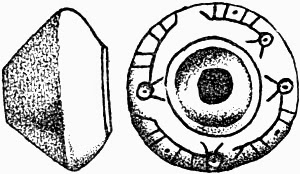
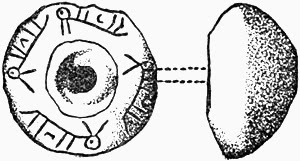
What does this remind you of? Swastika, the symbol of the sun, fire, lightning? The spinning of our galaxy? Swastika was the symbol of Ilios, the thundering sun god. Was Ilios the city named after Ilios the god? It is very interesting that Bull and swastika are often found together. And that both Crom Dubh in Ireland and Ilios, Perun in Serbia have a bull as their sacrificial animal.
Once the threshing floor is constructed it can be used for both threshing and as a solar observatory. What you are actually observing is the shadow made by the central stake or a standing stone. At the sunrise and sunset the shadow will be long enough to cut the circle at the oposite end. This is extremely precise way of marking the sunrise point. This stake is in Serbian known as „stožer„. This is a very interesting word which means pivot, central standing pole. The sun literally pivots around it both daily and yearly in the same way bulls or horses pivot around the stožer pole during threshing. This is a very ancient word built from stoj, staj + ga, gar, ger = standing, upright + stick, pole, stake, spear = pillar.
A hay stack, or wheat stack is called „stog” and every stog is built around the central stake, pole stožer = stog + ger, gar = stack + pole.
Co ci to przypomina? Swastyka, symbol słońca, ognia, błyskawicy? Wirowanie naszej galaktyki? Swastyka była symbolem Iliosa, boga gromowego słońca. Czy Ilios to miasto nazwane na cześć boga Iliosa? To bardzo interesujące, że Byk i swastyka często występują razem. I że zarówno Crom Dubh w Irlandii, jak i Ilios, Perun w Serbii mają byka jako swoje ofiarne zwierzę.
Gumno jest zbudowane w taki sposób, że można go wykorzystać zarówno do omłotu, jak i jako obserwatorium słoneczne. To, co faktycznie obserwujesz, to cień rzucany przez kołek centralny lub stojący kamień. O wschodzie i zachodzie słońca cień będzie wystarczająco długi, aby przeciąć koło na przeciwległym końcu. Jest to niezwykle precyzyjny sposób wyznaczania punktu wschodu słońca. Ten kołek ośrodkowy jest w języku serbskim nazywany „stožer”. To bardzo interesujące słowo, które oznacza czop, ośrodkowy kołek (kół, czyli centralny punkt koła/kręgu – biegun CB). Słońce dosłownie obraca się wokół niego zarówno codziennie, jak i corocznie, w taki sam sposób, jak byki lub konie obracają się wokół owego kołka podczas omłotu. Jest to bardzo starożytne słowo zbudowane ze stoj, staj + ga, gar, ger = stojący (stojak) , prosty/pionowy/prawy+ kół, drąg, słup, pal, włócznia = filar – STOJAK.
Stos siana lub pszenicy nazywa się „stog”, a każdy stog jest zbudowany wokół środkowego kołka, słupa stožer = stog + ger, gar = stos + słup.
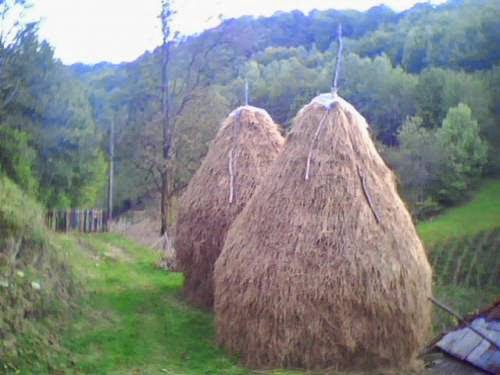
Here are some examples of threshing floors from Croatia. Some of them are still used today in exactly the same way they were used thousands of years ago.
Oto kilka przykładów gumna z Chorwacji. Niektóre z nich są dziś używane dokładnie tak samo, jak tysiące lat temu.
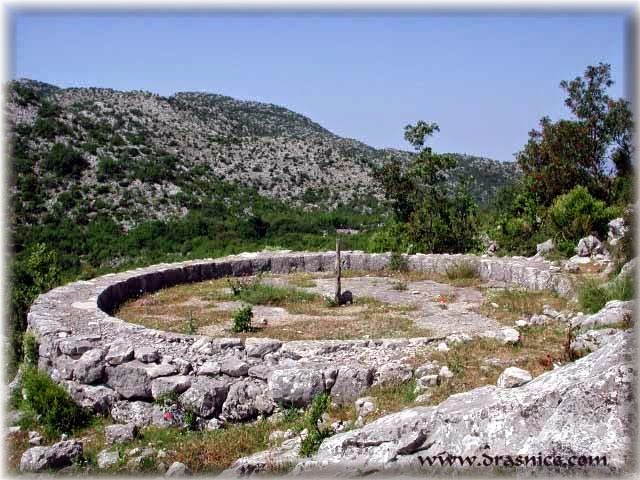
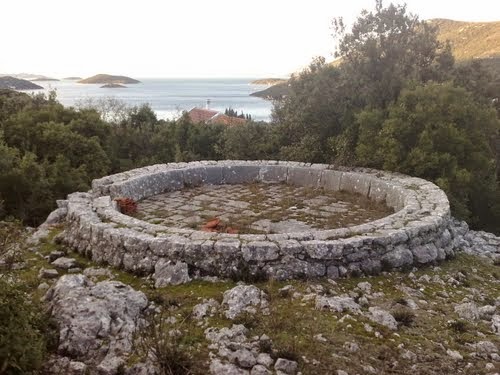
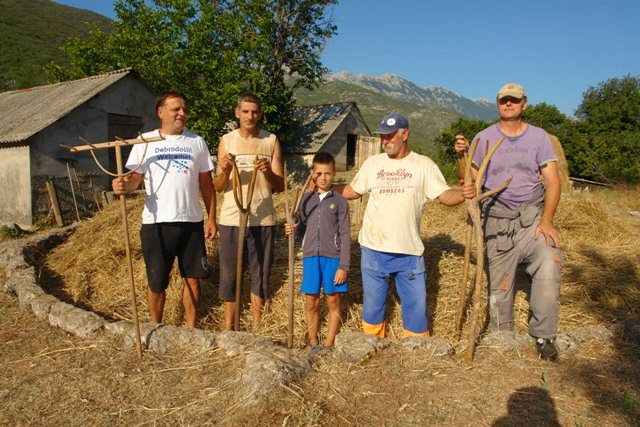
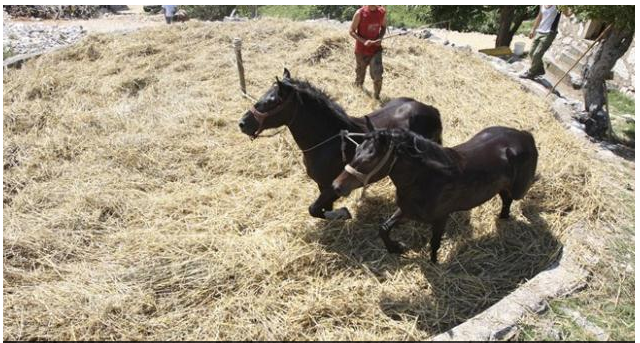
Please note the central stake, pole „stožer” in the middle of the threshing floors.
This film is from 1989 from Croatia, when people still used gumno to thresh the wheat:
Have a look at these pictures from Croatia, showing people in traditional clothing reenacting the harvest procedure on gumno, threshing floor:
Zwróć uwagę na środkowy słupek, słup „stožer” pośrodku klepiska.
Ten film pochodzi z 1989 roku z Chorwacji, kiedy ludzie wciąż używali gumna do omłotu pszenicy:
Spójrz na te zdjęcia z Chorwacji, pokazujące ludzi w tradycyjnych strojach odtwarzających procedurę zbiorów na gumnie, klepisku:

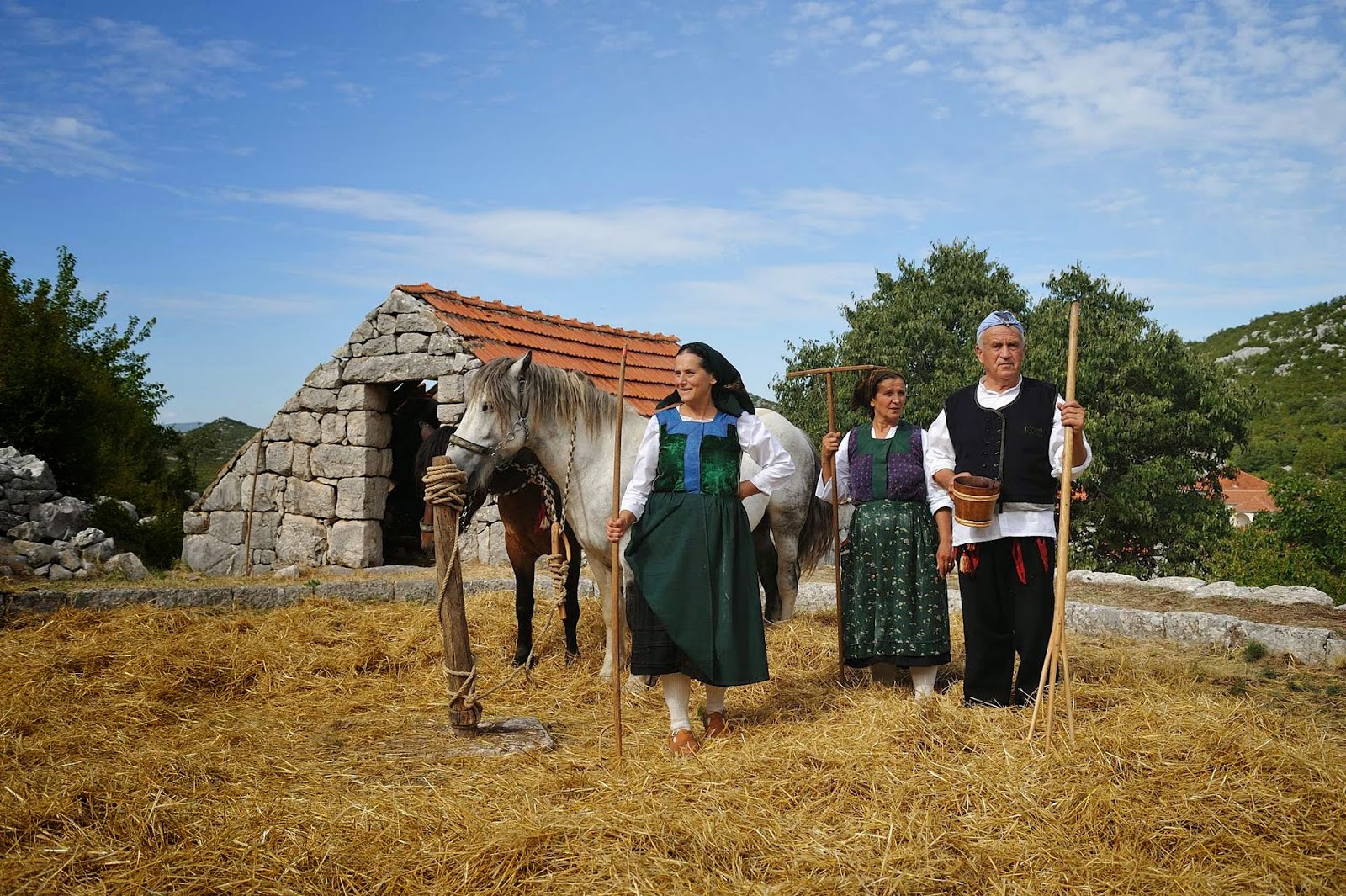


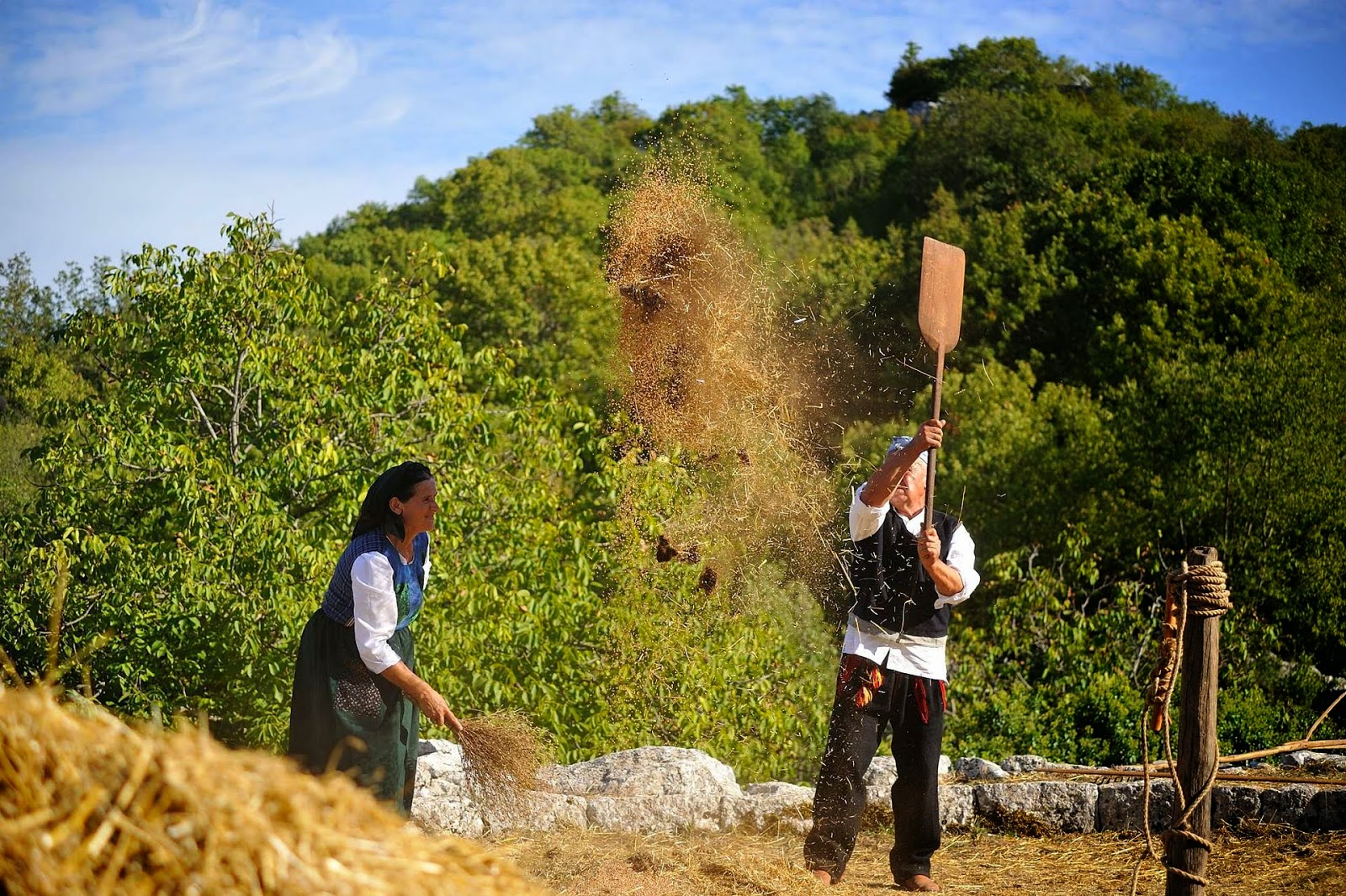
There are thousands of these stone circles all over the Balkans. Every village and sometimes every house had one. Sometimes they are made of stone, where stone was plentiful, but sometimes they were just a flat piece of land with a stick stack into the middle of it.
In 1950, Serbian ethnographer Nenad Janković published a book on folk astronomy called „Astronomija u predanjima, obicajima i umotvorinama Srba” (Astronomy in legends, customs and oral and written tradition of the Serbs). In it he expressed his great surprise at the ability of ordinary illiterate peasants to tell exact date and time without calendars and clocks. Professor Jankovic states that one of the main instruments used for these calendar and time calculations was the threshing floor. By looking at the shadow cast by the stožer, the central pole at sunrise, they were able to tell the date. And by looking at the shadow cast by the stožer, the central pole during the day they were able to tell the time. Threshing floor is a universal solar observatory, which at the same time can tell the date and the time. The main parts of this solar observatory were solar circle and its center, solar pole, stožer. Or if viewed from above, from heaven, the way Sun God would see it, a circle and a dot representing its center, solar pole, stožer. This is the symbol found all over the world and in Egypt it was the symbol of the sun, Ra. The below symbol is usually interpreted to mean sun disc, but I believe that it actually means sun circle, threshing floor and sun cycle observed from the threshing floor.
Istnieją tysiące tych kamiennych kręgów na całym Bałkanach. Każda wioska, a czasem każdy dom miał jeden. Czasami są one wykonane z kamienia, gdy kamieni było pod dostatkiem, ale czasami były tylko płaskim kawałkiem ziemi z patykiem w środku.
W 1950 roku serbski etnograf Nenad Janković opublikował książkę o astronomii ludowej zatytułowaną „Astronomija u predanjima, obicajima i umotvorinama Srba” (Astronomia w legendach, obyczajach oraz ustnych i pisemnych tradycjach Serbów). Wyraził w nim wielkie zdziwienie, że zwykli niepiśmienni chłopi potrafią podać dokładną datę i godzinę bez kalendarzy i zegarów. Profesor Jankovic stwierdza, że jednym z głównych przyrządów wykorzystywanych do obliczania kalendarza i czasu był klepisko (gumno). Patrząc na cień rzucany przez stojak, centralny słup o wschodzie słońca, byli w stanie określić datę. I patrząc na cień rzucany przez stojak (stożer), centralny biegun w ciągu dnia, byli w stanie powiedzieć godzinę. Klepisko to uniwersalne obserwatorium słoneczne, które jednocześnie może określić datę i godzinę. Głównymi częściami tego obserwatorium słonecznego były koło słoneczne i jego środek, biegun słoneczny, stožer. Lub patrząc z góry, z nieba, tak, jak widziałby je Bóg Słońca, okrąg i kropka reprezentująca jego środek, biegun słoneczny, stožer. Jest to symbol znaleziony na całym świecie, a w Egipcie był to symbol słońca Ra. Poniższy symbol jest zwykle interpretowany jako dysk słoneczny, ale uważam, że w rzeczywistości oznacza to koło słoneczne, klepisko i cykl słoneczny obserwowany z klepiska.
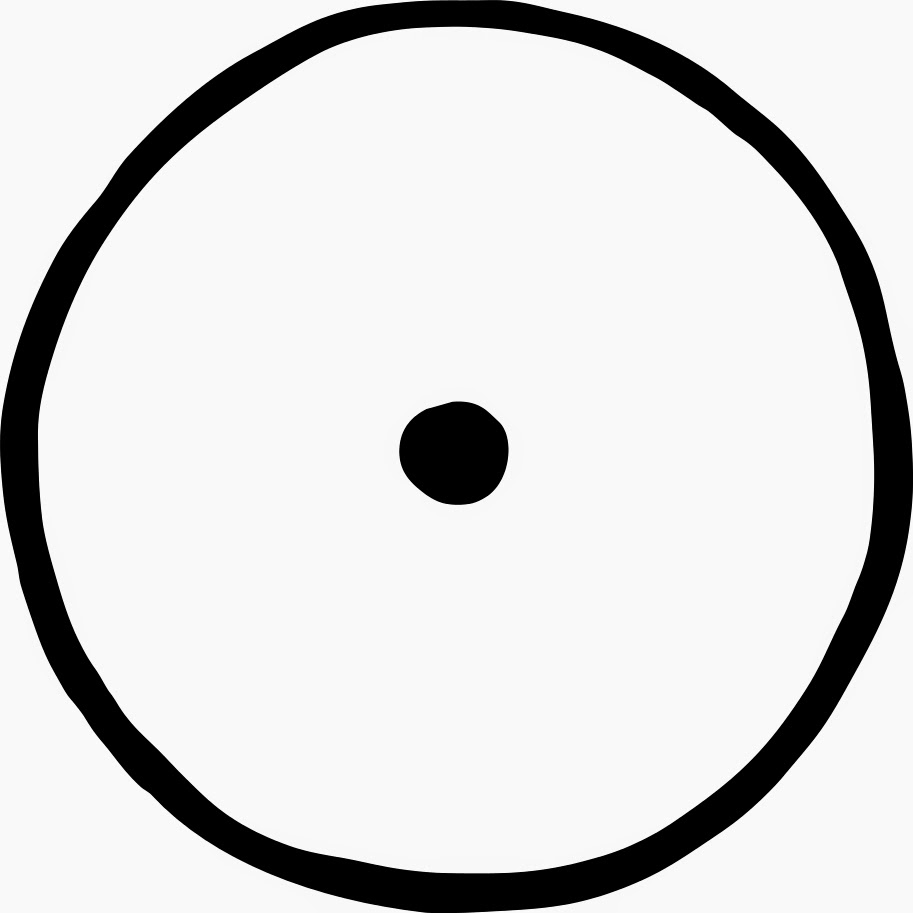
Greeks called the central solar pole, stožer of the sundial „gnomon” meaning the one which knows. This was because the central stake „new” the time and date.
English word hour comes from middle English houre, oure, from Anglo-Norman houre, from Old French houre, (h)ore, from Latin hōra (“hour”), from Ancient Greek ὥρα (hṓra, “any time or period, whether of the year, month, or day”). In Serbo Croatian we have a word „ura” meaning hour. I believe that the word comes from U + Ra = into + sun which is literally how the time periods are determined using sun circle. You look into the sun and the sun gives you the time and date. If we look at the ancient Greek word ora we see that it can have all these meanings: any defined period of time, season, (in plural): climate, year, time of day, hour, some specific time: right time, time for something, time of life: youth. Could the etymology of this word be Od + Ra = From + Sun, which again explains exactly where the time, date, season, year come from. From the sun. Or the etymology could be O + Ra = Circle, Cycle + Sun… I will talk about this in detail in one of my next posts.
Grecy nazywali centralny biegun słoneczny, czyli stožer zegara słonecznego „gnomon”, co znaczy ten, który wie. Jest tak, ponieważ stojak centralny wyznacza „nowy” datę i godzinę.
Angielskie słowo godzina pochodzi ze środkowo-angielskiego houre, oure, z anglo-normańskigo houre, od starofrancuskieho houre, (h) ore, z łacińskiego hora („hour”), od starogreckiego ὥρα (hṓra, „dowolny czas lub okres, niezależnie od tego, czy roku, miesiąca lub dnia ”). W serbsko-chorwackim mamy słowo „ura” oznaczające godzinę. Wierzę, że słowo pochodzi od U + Ra = do + słońca, co jest dosłownie sposobem określania okresów za pomocą koła słonecznego. Patrzysz w słońce, a słońce podaje ci godzinę i datę. Jeśli spojrzymy na starożytne greckie słowo ora, zauważymy, że może ono mieć wszystkie te znaczenia: dowolny określony okres czasu, pora roku (w liczbie mnogiej): klimat, rok, pora dnia, godzina, określony czas: właściwy czas, czas na coś, czas życia: młodość. Czy etymologia tego słowa może być Od + Ra = od + słonca, co ponownie wyjaśnia dokładnie, skąd pochodzi godzina, data, pora roku i rok. Ze słońca. Lub etymologia może być O + Ra = Koło, Cykl + Słońce … Opowiem o tym szczegółowo w jednym z moich następnych postów.
In Serbian we have these words:
O – the shape of our mouth when it makes sound O. Letter O. The sound of surprise when we see something new, unknown, circle, surrounding.
K – towards (pointing, direction of movement and observation)
L – line
KO = K + O = towards, pointing + surrounding = who, what
OKO = circle + direction + circle = around
OKO = O + KO = circle + who, what = what we use to look around, what we use to determine who is it, eye
W języku serbskim mamy następujące słowa:
O – kształt naszych ust, kiedy wydaje dźwięk O. Literę O. Dźwięk zaskoczenia, gdy widzimy coś nowego, nieznanego, otaczającego, koło.
K – w kierunku (wskazanie, kierunek ruchu i obserwacja)
L – linia
KO = K + O = w kierunku, wskazując + otoczenie = kto, co
OKO = okrąg + kierunek + okrąg = wokół
OKO = O + KO = koło + kto, co = czego używamy do rozglądania się, czego używamy, aby ustalić, kto to jest, oko

OKO (eye) gives us Vid (Sight) but only if Vid (Sun) gives us Videlo (light). The name of the Serbian Sun god literally means Sight. And without sight you can not gain any Veda (knowledge). I will write a separate article about Svetovid and how words vid (sight) and ved (knowledge) are embedded in Serbian language.
KOLO = K + O + L + O = direction + circle + line + circle = spinning circle, cycle, circular dance, wheel
OKOLO = around in circles
OKNO = window, through which we see
According to ethnographic research from the Balkan mountains conducted in the 19th century, threshing floor was the place where all the village meetings, celebrations and ceremonies took place.The ethnographers say that this is because threshing floors were the only flat smooth surfaces big enough to accommodate many people. But was this the only reason? Were threshing floors places where village meetings, celebrations and ceremonies took place because they were considered to be the sacred ground, the place where god lived on earth? I believe so.
In Montenegro young people, wearing flower wreaths on their heads, would gather on „Vilino Gumno”, Fairy threshing floor, on the Feast of Ascension to sing songs about fairies and dance a circular dance kolo, oro. This is probably a remnant of an ancient fertility right, which was originally probably held at the beginning of summer, on the day of the young Sun, Jarilo which falls on the 6th of May.
OKO (oko) daje nam Vid (widok), ale tylko jeśli Vid (słońce) daje nam Videlo (światło). Imię serbskiego boga Słońca dosłownie oznacza Widok (Widzenie,Widzący CB). I bez widzenia nie można zdobyć Wedy (wiedzy). Napiszę osobny artykuł o Svetovidzie i tym, jak słowa vid (widok, widzneie) i ved (wiedza) są osadzone w języku serbskim.
KOLO = K + O + L + O = kierunek + koło + linia + koło = wirujący okrąg, cykl, taniec okrągły, koło
OKOLO = w kółko
OKNO = okno, przez które widzimy
Według badań etnograficznych z Bałkanów przeprowadzonych w XIX wieku, klepisko/gumno było miejscem, w którym odbywały się wszystkie spotkania, uroczystości, a też obrzędy w wiosce. Etnografowie twierdzą, że dzieje się tak, ponieważ klepiska były jedynymi płaskimi gładkimi powierzchniami wystarczająco dużymi, aby pomieścić wielu ludzi. Ale czy to był jedyny powód? Czy klepiska były miejscami, w których odbywały się spotkania, uroczystości i obrzędy na wsi, ponieważ uważano je za świętą ziemię, miejsce, w którym Bóg mieszkał na ziemi? Tak mi się wydaje.
W Czarnogórze młodzi ludzie, ubrani w wieńce z kwiatów, zbierali się na „Vilino Gumno”, klepisku wróżki, w Święto Wniebowstąpienia, aby śpiewać piosenki o wróżkach i tańczyć w kręgu kolo oro. Jest to prawdopodobnie pozostałość starożytnego obrzędu płodności, które pierwotnie miało miejsce prawdopodobnie na początku lata, w dniu młodego Słońca Jariły, które przypada 6 maja.
At the same time Serbian tradition says that threshing floors are a favorite meeting place of demons and witches and one of the main places that should be avoided during the night. Witches come to threshing floors to dance. This is typical reversal of positives into negative which was a favorite method of brain washing used by Christians during forced conversions. Old gods become devils and demons, and places where old gods lived on earth become gathering places of demons and witches. What is interesting is that people believe that witches only live on unused threshing floors. Once people stop visiting god’s house on earth, the god leaves as well, and demons move in….
Western Serbs have also preserved this custom related to the birth of the young Sun god, the beginning of the new solar year, new year. On Christmas day, the hay that was used to decorate the houses on Christmas eve is brought out and strewn on the threshing floor. On the first of January, which is in Serbia called „mladi Božić” meaning young God, a magic ritual threshing is performed. A special votive bread is made in a shape of a circle with a hole in the middle (torus, wheel) decorated with cuts on the outer edge. The bread is called „kovrtanj”, „kovrtač” meaning the one that spins, and is used for magical ceremonies linked to fertility.
Jednocześnie serbska tradycja mówi, że klepiska są ulubionym miejscem spotkań demonów i czarownic oraz jednym z głównych miejsc, których należy unikać w nocy. Czarownice przychodzą na klepisko, by tańczyć. Jest to typowe odwrócenie pozytywów na negatywne, co było ulubioną metodą prania mózgu stosowaną przez chrześcijan podczas przymusowej konwersji. Starzy bogowie stają się diabłami i demonami, a miejscach, w których żyli dawni bogowie na ziemi, gromadzą się demony i czarownice. Co ciekawe, ludzie wierzą, że czarownice żyją tylko na nieużywanych klepiskach. Gdy ludzie przestaną odwiedzać dom boga na ziemi, bóg również z niego wychodzi, a demony wprowadzają się …
Zachodni Serbowie zachowali również ten zwyczaj związany z narodzinami młodego boga Słońca, początkiem nowego roku słonecznego, nowego roku. W Boże Narodzenie siano, które było używane do dekoracji domów w Wigilię Bożego Narodzenia, jest wyjmowane i rozsypywane na klepisku. Pierwszego stycznia, który w Serbii nazywa się „mladi Božić”, co oznacza młodego Boga, odbywa się magiczny rytualny omłot. Specjalny chleb wotywny jest wykonany w kształcie koła z otworem pośrodku (torus, koło) ozdobionym nacięciami na zewnętrznej krawędzi. Chleb nazywa się „kovrtanj” (kołowrót, który w Krakowie jest znany jako obwarzanek = ob-war-RA CB), „kovrtač”, co oznacza ten, który się kręci i służy do magicznych ceremonii związanych z płodnością.

First one is performed in the cow shed where the bread is put on a bull’s horn. The way it rolls off it is interpreted as an indication whether the next harvest will be good or bad. The second one is performed on the threshing floor. A father gets up before the dawn and takes all the children out onto the threshing floor. He sticks the votive solar bread onto the stožer, central pole of the threshing floor. The father holds onto the bread and all the children hold on to him and they all walk around the stožer pole performing a ritual threshing. Then they all break the votive bread, turn towards the rising sun and cross themselves greeting the young God, Sun on his birthday, the beginning of the new Solar Year. Then they pick up the hay from the threshing floor and decorate fruit trees with it performing fertility rituals. The hay is also added to chicken nests to ensure fertility. No hay is supposed be left on the threshing floor because it contains magical properties.
In central Serbia, and other parts of the Balkans, on the first day of threshing, the first sheaf of grain is stuck on top of the stožer, the central pole of the threshing floor, as an offering. This picture is from Poreč region of Makedonija:
Pierwszy taniec obrzędowy odbywa się w oborze dla krów, gdzie chleb zakłada się na rogu byka. Sposób, w jaki się on z rogu zsuwa, jest interpretowany jako wskazówka, czy następne zbiory będą dobre, czy złe. Drugi wykonywany jest na klepisku. Ojciec wstaje przed świtem i zabiera wszystkie dzieci na klepisko. Nakłada wotywny chleb słoneczny (ob-war-RA) na szpic kóła/kołaka/stojaka/stożera, centralnego słupa klepiska. Ojciec trzyma się chleba, a wszystkie dzieci trzymają się jego i wszystkie chodzą wokół stojaka wykonując rytualny omłot. Następnie wszyscy łamią wotywny chleb, zwracają się w stronę wschodzącego słońca i czynia znak krzyżaę, witając młodego Boga, Słońce w jego urodziny, początek nowego roku słonecznego. Następnie zbierają siano z klepiska i dekorują nim drzewa owocowe, wykonując rytuały płodności. Siano dodaje się również do gniazd kurcząt, aby zapewnić płodność. Na omłotowej podłodze nie pozostawia się siana, ponieważ ma ono magiczne właściwości.
W centralnej Serbii i innych częściach Bałkanów, pierwszego dnia omłotu, pierwszy snop zboża zatyka się na szczycie stojaka, centralnego słupa omłotu, jako ofiarę. To zdjęcie pochodzi z regionu Poreč Makedonija:
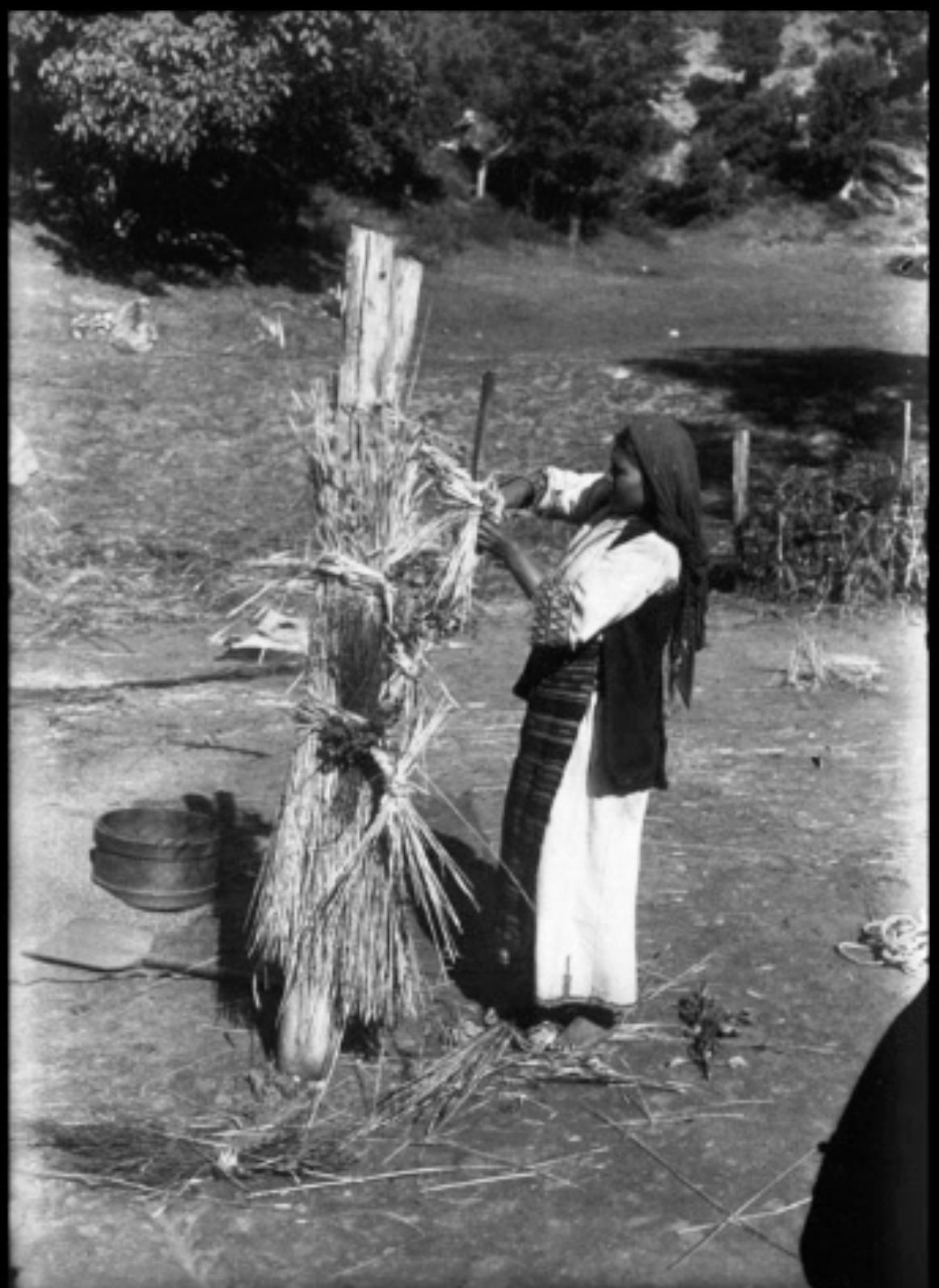
Then the village or family leader walks across the threshing floor, east to west, north to south, creating the image of the solar cross. The same solar cross that we find on česnica (Cyrillic: чесница, Serbian pronunciation: [tʃeːsnitsa]; derived from the noun čest, meaning „share”) which is the ceremonial, round loaf of bread that is an indispensable part of Christmas dinner in Serbian tradition.
Następnie przywódca wioski lub rodziny idzie przez klepisko, ze wschodu na zachód, z północy na południe, tworząc obraz krzyża słonecznego na ziemi. Ten sam krzyż słoneczny, który znajdujemy na Česnicy (cyrylica: чесница, serbska wymowa: [tʃeːsnitsa]; pochodzi od rzeczownika čest, co oznacza „udział” (Częścica/ Częstunek i część/udział/działka CB)), który jest ceremonialnym, okrągłym bochenkiem chleba, który jest nieodzowną częścią świątecznej kolacji w tradycji serbskiej.
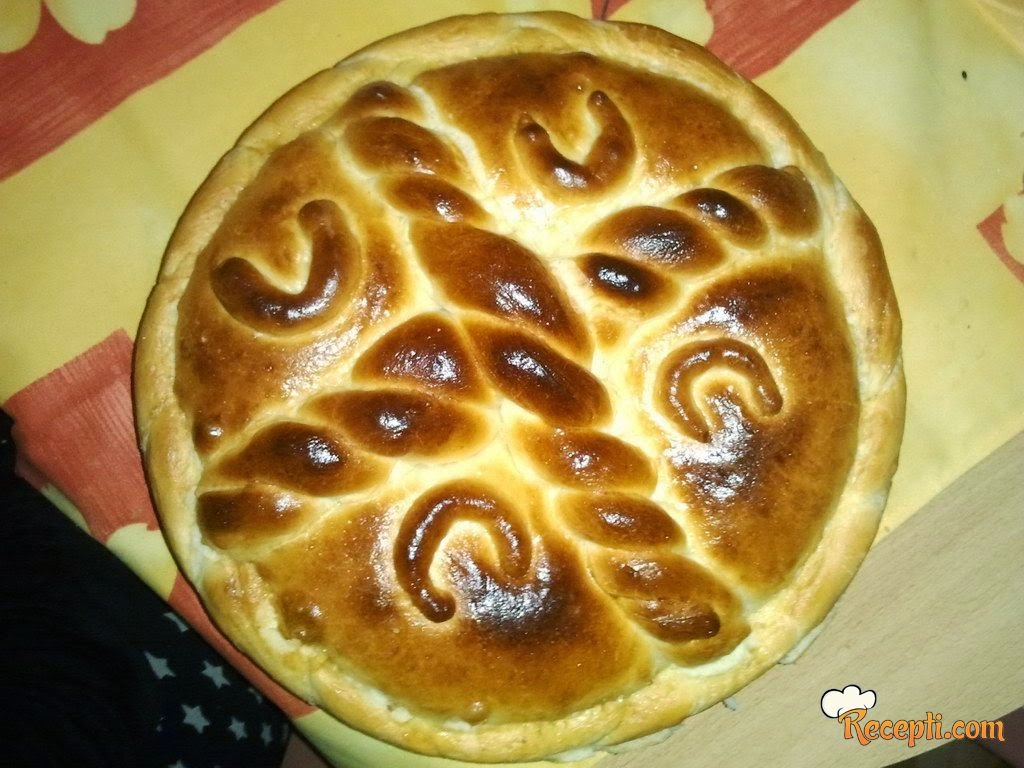
So here we have a direct link between the Sun, the Threshing floor, the Solar cross and Bread.
ORO – Slavic circular solar dance. Same dance if found in other parts of the Balkans and was probably originally a ritual solar dance.
Mamy więc bezpośredni związek między słońcem, klepiskiem/gumnem i omłotem, krzyżem słonecznym i chlebem.
ORO – słowiański taniec w kręgu, koło słoneczne. Ten sam taniec, który został znaleziony w innych częściach Bałkanów i prawdopodobnie był pierwotnie rytualnym tańcem słonecznym.
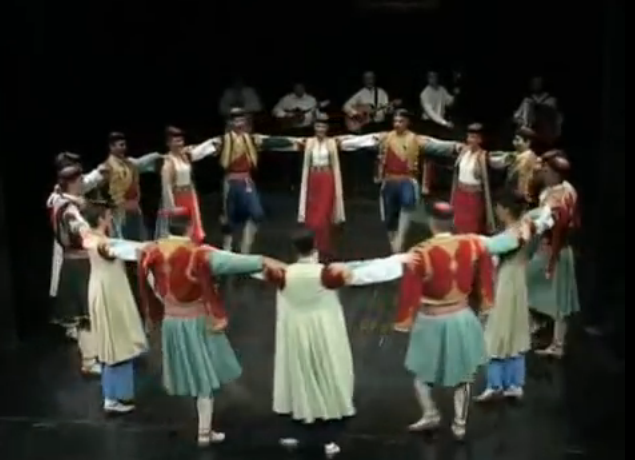
Is symbolism of ORO the same as symbolism of Stonehenge? Were the original henges threshing floors as well as a sun circles, solar observatories?
Czy symbolika ORO jest taka sama jak symbolika Stonehenge? Czy oryginalne henges klepiska, gumnai, to także koła słoneczne, obserwatoria słoneczne?

And is the outer stone circle just a stone representation of ORO, sun dance, sun cycle, sun circle, danced as part of some Solar ceremony representing the never ending turning of the sun wheel?
I czy zewnętrzny kamienny krąg jest tylko kamiennym przedstawieniem ORO, tańca słonecznego, cyklu słonecznego, kręgu słonecznego, tańczonego w ramach jakiejś ceremonii słonecznej reprezentującej niekończące się obracanie koła słonecznego?
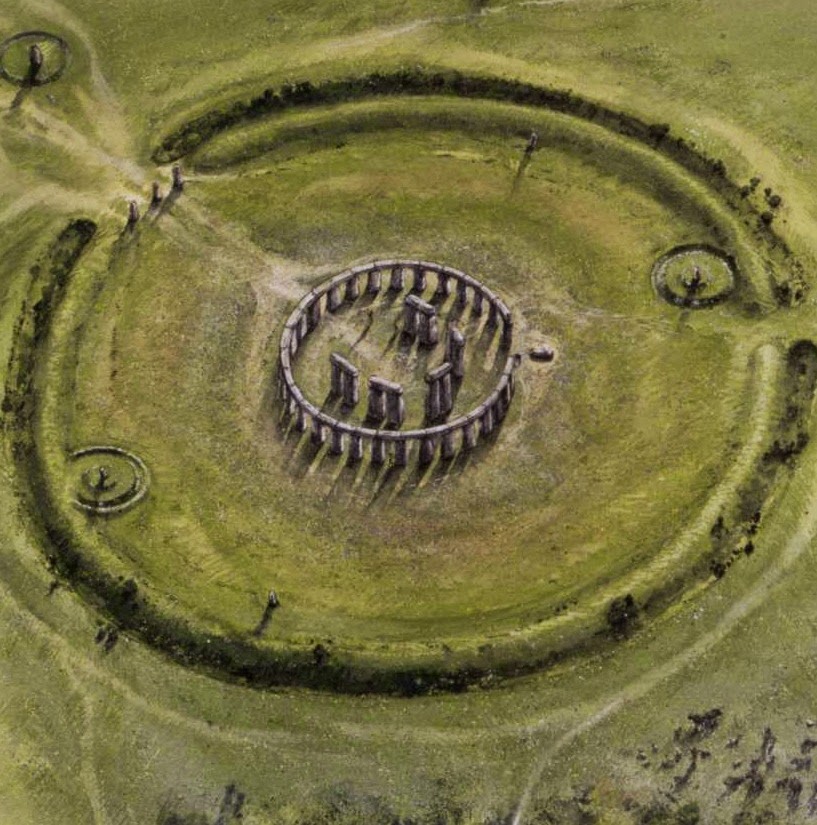
Serbian peasants have preserved this link between the God (Vid), Sun, Time and Harvest expressed through the threshing floor for thousands of years. Threshing floor is the place where God (Vid), Sun shows himself to people as time and as grain.
But I don’t think that it is only the threshing floor which has an astronomical symbolism. I believe that all the items involved in the process of harvest have astronomical symbolism. If threshing floor is symbolically linked to the sun, is sickle symbolically linked to the moon?
These are two neolithic sickles and one modern sickles:
Serbscy chłopi zachowali ten związek między Bogiem (Vid), Słońcem, Czasem i Żniwami wyrażony przez klepisko/gumno przez tysiące lat. Klepisko to miejsce, w którym Bóg (Vid), Słońce pokazuje się ludziom jako czas i ziarno.
Ale nie sądzę, że tylko młócka ma astronomiczną symbolikę. Uważam, że wszystkie przedmioty biorące udział w procesie zbiorów mają astronomiczną symbolikę. Jeśli klepisko jest symbolicznie powiązane ze słońcem, czy sierp jest symbolicznie związany z księżycem?
Są tu dwa sierpy neolityczne i jeden sierp współczesny:

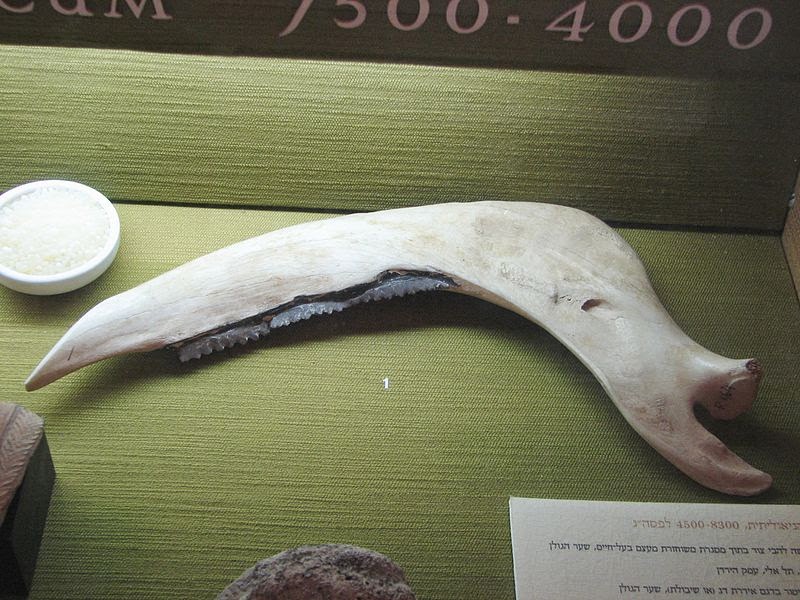
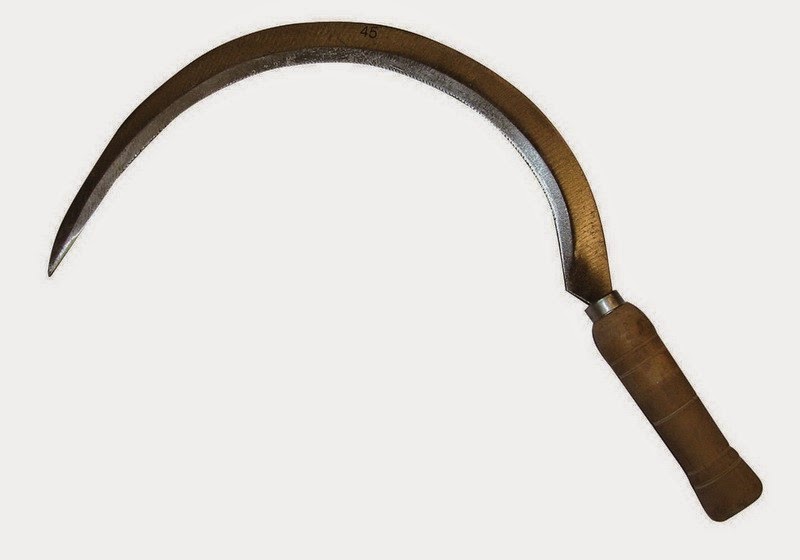
Compare them with the moon calendar from Serbia. They have the same shape, the shape of a young moon.
Porównaj je z kalendarzem księżycowym z Serbii. Mają ten sam kształt, kształt młodego księżyca.
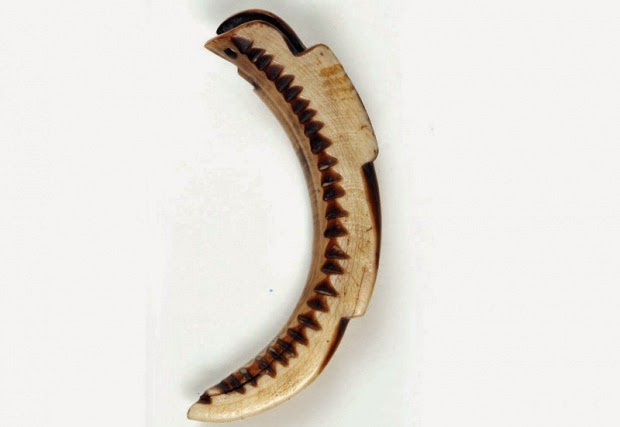

Sickle is today called Srp in Serbian, but I believe that it was original called something like Latin sekula meaning sickle. Sekula is actually a South Slavic personal name. South Slavic languages have the largest cluster of cutting words based on the root „sec” with only Irish having a similar world cluster.
If threshing floor is linked to the sun, if sickle is linked to the moon are grain seeds linked to the stars? This is quite possible.
In western culture the name „Milky Way” is derived from its appearance as a dim un-resolved „milky” glowing band arching across the night sky. The term is a translation of the Classical Latin via lactea, in turn derived from the Hellenistic Greekγαλαξίας, short for γαλαξίας κύκλος (pr. galaktikos kyklos, „milky circle”). The Ancient Greek γαλαξίας (galaxias), from root γαλακτ-, γάλα (milk) + -ίας (forming adjectives), is also the root of „galaxy”, the name for our, and later all such, collections of stars.
You can find an extensive list of names for milky from different languages around the world on this page and this page (two different lists).
What is interesting is that we can see that by far most Evroasian people use Milk or cow, sheep way metaphor to describe our galaxy. All of these names for our galaxy which are linked to milk have root in nomadic herding people. The second most common metaphor used in Evroasia to describe our galaxy is birds way. This is again linked to migration.
But in Serbo Croatian, Persian, Arabic, Turkish, Armenian, Kirgiz, Uighur, Uzbek, Chechen tradition, the metaphor for our galaxy is linked to straw, hay. What is connection between these people?
Maybe Serbian tradition can help us understand this straw link. In Serbian tradition that our galaxy is known as „Kumova Slama” meaning „The Godfather’s hay”. But what if the original expression was „Gumnova Slama” meaning „Threshing floor hay”? Gumno is Serbo Croatian word. And it is only in Serbo Croatian tradition that we have the link between our galaxy, hay and threshing floor. That „Gumnova Slama” meaning „Threshing floor hay” is probably the original name for our galaxy in Serbo Croatian tradition can be seen from the name Serbs have for the constellation of Orion. In Serbian tradition he is known as Orač, meaning the plowman. In Serbian Orion = Ore + on = Plows + he = Plowman. In Serbian tradition, Kumova Slama (Gumnova Slama), threshing floor hay, is what a soul needs to cross to reach God. What do we reach when we cross threshing floor hay? We reach stožer, the central pole of the threshing floor. Is this the representation of the center of our galaxy? Is this where or what god is? Is the stožer earthly representation of the galactic pole around which galaxy rotates?
Sierp jest dziś nazywany po serbsku Srp, ale wierzę, że był pierwotnie nazywany czymś w rodzaju łacińskiej sekuli oznaczającej sierp. Sekula to tak naprawdę miano południowosłowiańskie. Języki południowosłowiańskie mają największą grupę ciętych słów opartych na rdzeniu „sec”, a tylko Irlandczycy mają podobny klaster światowy.
Jeśli omłot jest połączony ze słońcem, jeśli sierp jest połączony z księżycem, czy ziarna zbóż są połączone z gwiazdami? Jest to całkiem możliwe.
W kulturze zachodniej nazwa „Droga Mleczna” wywodzi się od jej wyglądu jako słabego nierozdzielonego „mlecznego” świecącego pasma wyginającego się na nocnym niebie. Termin ten jest tłumaczeniem klasycznej łaciny poprzez lactea, z kolei pochodzącej z greki γαλαξίας, w skrócie γαλαξίας κύκλος (pr. Galaktikos kyklos, „mleczny krąg”). Starożytna grecka γαλαξίας (galaxias), od korzenia γαλακτ-, γάλα (mleko) + -ίας (tworzenie przymiotników), jest również rdzeniem „galaktyki”, nazwy naszego zbioru gwiazd, a później wszystkich takich zbiorów gwiazd.
Na tej stronie i tej stronie można znaleźć obszerną listę nazw mlecznych z różnych języków na całym świecie (dwie różne listy).
Co ciekawe, widzimy, że zdecydowana większość ludzi z Euroazji posługuje się metaforą mlecznej lub krowiej, lub owczej drogi, aby opisać naszą galaktykę. Wszystkie te nazwy naszej galaktyki, które są powiązane z mlekiem, mają swoje korzenie w plemionach nomadów. Drugą najczęstszą metaforą stosowaną w Euroazji do opisania naszej galaktyki jest droga ptaków. Jest to ponownie związane z migracją.
Ale w serbsko-chorwackim, perskim, arabskim, tureckim, armeńskim, kirgiskim, ujgurskim, uzbeckim, czeczeńskim tradycyjna metafora naszej galaktyki jest związana ze słomą i sianem. Jaki jest związek między tymi ludźmi?
Może serbska tradycja pomoże nam zrozumieć ten słomiany związek. W serbskiej tradycji mówi się, że nasza galaktyka znana jest jako „Kumova Slama”, co oznacza „Siano Ojca Chrzestnego” (Słoma Kuma CB). Ale co jeśli oryginalnym wyrażeniem było „Gumnowa Slama”, co oznacza „Słoma zmłócona na Gumnie”? Gumno to serbsko-chorwackie słowo (także polskie! CB). I tylko w serbsko-chorwackiej tradycji mamy związek między naszą galaktyką, sianem i klepiskiem. To, że „Gumnova Slama”, co oznacza „Słoma zmłócona na Gumnie”, jest prawdopodobnie oryginalną nazwą naszej galaktyki w serbsko-chorwackiej tradycji, można ją zobaczyć po nazwie Serbów dla konstelacji Oriona. W tradycji serbskiej znany jest jako Orač, co oznacza oracz. W serbskim Orionie = ore + on = ora(dło) + on = oracz. W serbskiej tradycji Kumova Slama (Gumnova Slama), młócenie slomy na gumnie, jest tym, co dusza musi przekroczyć, aby dotrzeć do Boga. Co osiągamy, gdy przechodzimy przez słomę omłotową? Docieramy do stožer, środkowego bieguna omłotu. Czy to reprezentuje centrum naszej galaktyki? Czy to gdzie, lub czym jest bóg? Czy stróżar (stożer) to ziemska reprezentacja bieguna galaktycznego wokół którego obraca się galaktyka?
I said many times that Serbs are a mixed population of many different peoples. Each of them brought into the mix part of their own culture and language. Looking at the Serbo Croatian metaphors used to describe our galaxy, we see that we can find both „Mlečni put” meaning milky way, which comes from the Slavic tradition and „Gumnova Slama” meaning „Threshing floor hay”. Whose is this second culture that we are unraveling here? Why is it that we find such a strong solar – agricultural belief system in Serbian tradition? Is this tradition found in Serbian Croatian, Persian, Arabic, Turkish, Armenian, Kirgiz, Uighur, Uzbek, Chechen people coming to us from the time of the first farmers? Did you notice that Hebrew tradition also uses Milk way metaphor characteristic of nomad herders to describe our galaxy, which is in keeping with their nomadic history? So who were the first farmers then?
So we have gumno (threshing floor, circle, sun, bread), stožer (threshing floor pole, galactic axis), srp (crescent, moon), slama (hay, galaxy), zrno (grain, stars), all linked to a harvest, the culmination of the agricultural year.
The threshing process is the final part of the harvest. It is the moment when the months of hard work finally turn into food. This is the moment when the people will find out whether they will feast or whether they will starve through the winter. But it is not just the months of hard work that were put into producing the grain that is being threshed at the threshing floor. These months were also months of prayers to the Sun, the god of Grain.
First there were spring prayers to the young god of Grain Jarilo. These prayers were performed during plowing, sawing and sprouting season. The prayers were asking the young god of fertility to help insure that the land gets impregnated with the wheat seeds and that the wheat sprouts.
Second there were prayers to the mature god of Grain Vid. These prayers were performed during the growing of the grain, when sun is needed to grow the wheat seeds and fill them with goodness.
Third there were prayers to the old god of Thunder and Rain, Perun, Ilios. These prayers were performed during the ripening of the grain just before the harvest, when light rain is needed to ensure that the wheat is not destroyed by the drought.
But all these three gods are just three faces, three ages of one god, the god of grain, Dabog, the God that gives also known as Hromi Daba, Triglav, Thundering sun Ilios.
Just before the harvest, the final, most important prayer to the Sun, the god of weather and the good of Grain is uttered: „Please god give us enough grain so that we can survive through the winter”. Then the grain is harvested and threshing starts. The threshing is the moment when the months of hard work finally turn into food. The threshing time is the time of truth. The threshing floor becomes the place where every year the relationship between the people and their god is being tested. If the harvest was bountiful, the god heard our prayers and has delivered. If the harvest was poor, the god did not hear our prayers or heard them and decided to ignore them. Why? What did we do wrong? What if we didn’t do anything wrong, what if we were praying to the wrong god?
Were threshing floors, sun circles, the first temples dedicated to the Sun, the god of grain farmers?
Wielokrotnie mówiłem, że Serbowie są mieszaną populacją wielu różnych ludów. Każdy z nich wniósł część mieszanki własnej kultury i języka. Patrząc na serbsko-chorwackie metafory użyte do opisania naszej galaktyki, widzimy, że możemy znaleźć zarówno „Mlečni put”, co oznacza mleczną drogę, która wywodzi się z tradycji słowiańskiej, i „Gumnova Slama”, co oznacza „Słoma zmłócona na Gumnie”. Czyja jest ta druga kultura, którą tutaj rozwijamy? Dlaczego w serbskiej tradycji znajdujemy tak silny system przekonań słoneczno-rolniczych? Czy tę tradycję można znaleźć w serbskiej, chorwackiej, perskiej, arabskiej, tureckiej, armeńskiej, kirgiskiej, ujgurskiej, uzbeckiej, czeczeńskiej, która przybywa do nas od czasów pierwszych rolników? Czy zauważyliście, że tradycja hebrajska wykorzystuje także metaforę „Mleczną” charakterystyczną dla pasterzy nomadów, aby opisać naszą galaktykę, co jest zgodne z ich nomadyczną historią? Kim więc byli pierwsi rolnicy?
Mamy więc gumno (klepisko, koło, słońce, chleb), stožer (słup klepiska, oś galaktyczna), srp (półksiężyc, księżyc), slama (siano, galaktyka), zrno (ziarno, gwiazdy), wszystkie powiązane ze żniwami, kulminacją roku rolniczego.
Proces omłotu jest ostatnią częścią zbiorów. To moment, w którym miesiące ciężkiej pracy w końcu zamieniają się w jedzenie. To jest moment, kiedy ludzie dowiedzą się, czy będą ucztować, czy głodować przez zimę. Ale nie tylko miesiące ciężkiej pracy zostały włożone w produkcję ziarna, które jest młócone na klepisku. Te miesiące były również miesiącami modlitw do Słońca, boga Ziarna.
Najpierw były wiosenne modlitwy do młodego boga Ziarna Jariły. Te modlitwy były wykonywane podczas orki, siewu i kiełkowania. Modlitwy prosiły młodego boga płodności o pomoc w zapewnieniu, że ziemia zostanie zapłodniona ziarnami pszenicy i że pszenica wykiełkuje.
Po drugie, były modlitwy do dojrzałego boga Zbożowego Vida (Vida Ziarna – Jądra Orchu CB). Modlitwy te odbywały się podczas uprawy zboża, kiedy słońce potrzebuje nasiona potrzebują słońca a słońce napełnia je i sporzy (powiększa CB).
Po trzecie, były modlitwy do starego boga piorunów i deszczu, Peruna- Iliosa (Heliosa CB). Modlitwy te były wykonywane podczas dojrzewania ziarna tuż przed zbiorami, kiedy potrzebny jest lekki deszcz, aby pszenica nie uległa zniszczeniu w wyniku suszy.
Ale wszyscy trzej bogowie są tylko trzema twarzami, trzema obliczami jednego boga, boga zboża, Daboga, boga, który daje także znanego jako Hromi Daba, Triglava, grzmiące słońce Ilios.
Tuż przed żniwem wypowiadana jest ostatnia, najważniejsza modlitwa do Słońca, boga pogody i dobrego Ziarna: „Boże, proszę, daj nam wystarczającą ilość ziarna, abyśmy mogli przetrwać zimę”. Następnie ziarno jest zbierane i rozpoczyna się omłot. Omłot to moment, w którym miesiące ciężkiej pracy w końcu zamieniają się w jedzenie. Czas omłotu jest czasem prawdy. Klepisko staje się miejscem, w którym co roku testowane są relacje między ludźmi a ich bogiem. Jeśli żniwo było obfite, bóg wysłuchał naszych modlitw i wydał je. Jeśli żniwo było słabe, bóg nie słyszał naszych modlitw ani ich nie przyjął i postanowił je zignorować. Czemu? Co zrobiliśmy źle? Co jeśli nie zrobimy nic złego, albo jeśli będziemy modlić się do złego boga?
Czy klepiska/gumna, koła słoneczne były pierwszymi świątyniami poświęconymi Słońcu, bogu rolników zbóż?
Źródło: Old European culture
